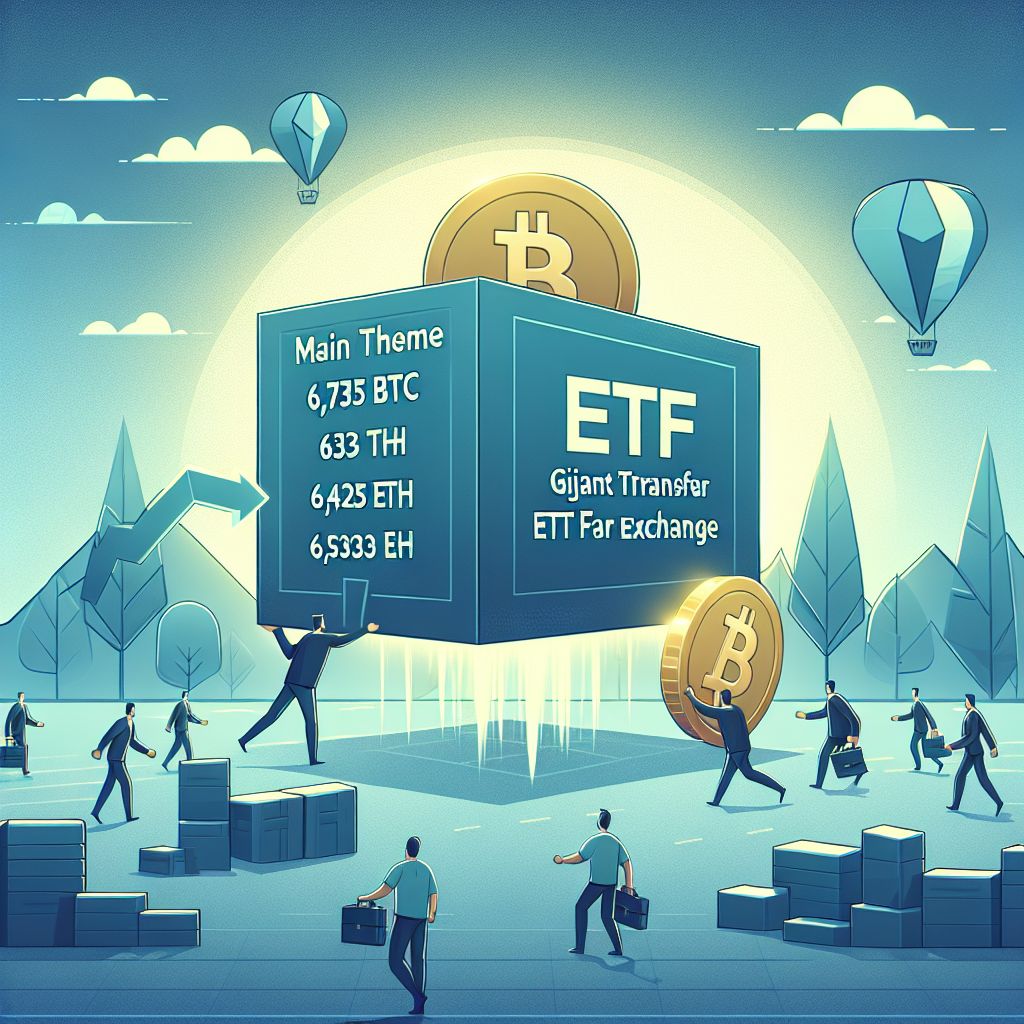Overview: What Happened
In a notable institutional movement during 2025, a large Bitcoin ETF executed a transfer of roughly 6,735 BTC—valued at approximately $610 million at the time—to a major custodial exchange platform. That transfer was accompanied by a simultaneous movement of about 64,706 ETH, worth roughly $190 million.

Transactions of this scale are increasingly common since the introduction and expansion of regulated spot Bitcoin ETF products. They illustrate how institutional strategies now interact with exchange liquidity and price discovery in ways that matter to every market participant.
Why Large ETF Transfers Matter
Large transfers from ETF custody addresses to trading venues are meaningful for several reasons:
- They often signal preparation for increased trading or liquidity provision.
- They represent active position and risk management from institutional managers.
- They can temporarily affect order book depth and price volatility, especially around concentrated move windows.
In 2025, as ETF adoption has continued, these transfers provide useful on-chain data points for evaluating institutional sentiment without revealing specific trading motivations.
Institutional Adoption and Market Structure
Since the broader rollout of regulated Bitcoin ETF products, institutional exposure to crypto has shifted from OTC and custodial wallets toward ETF channels that trade on regulated markets. The ETF wrapper allows asset managers to scale allocations and adapt liquidity strategies while providing a regulated pathway for traditional investors.
Consequently, large transfers between ETF custody and exchanges now act as a bridge between institutional asset management and spot market liquidity.
Immediate Market Implications
When several thousand BTC and tens of thousands of ETH are moved to an exchange, traders and market-makers typically watch for short-term effects:
- Increased sell- or buy-side liquidity depending on whether the funds are intended for distribution or accumulation.
- Wider spreads can narrow as market-makers respond to the larger available inventory.
- Temporary price pressure in either direction if execution is concentrated or poorly timed.
However, a transfer alone does not determine direction. Context—including timing, broader order flow, macro factors and communication from the asset manager—matters.
2025 Market Context: Why This Is Relevant Now
The crypto market in 2025 is evolving in several ways that amplify the significance of institutional transfers:
- ETF adoption has continued to grow, increasing assets under management (AUM) in regulated products and establishing deeper institutional liquidity.
- Regulatory frameworks in multiple jurisdictions have clarified rules for custody and asset servicing, encouraging larger institutional participation.
- Macro volatility and persistent interest in digital assets as an inflation hedge or portfolio diversifier have kept institutional allocation decisions dynamic.
These forces mean large on-chain movements are more likely to reflect active portfolio management rather than speculative repositioning alone.
How Traders and Investors Should Interpret These Signals
For retail traders, professional desks, and portfolio managers, treating such transfers as informative rather than determinative is key. Consider the following practical approaches:
- Monitor exchange inflows and outflows over multiple days to detect sustained inventory changes.
- Watch order book depth and implied liquidity rather than a single transfer figure.
- Combine on-chain transfer data with market indicators—volume, funding rates, options skew—to form a holistic view.
- Avoid overreacting to single large movements; instead, integrate them into a strategy that accounts for execution risk.
Risk Management Tips
- Size positions relative to realized volatility and liquidity conditions.
- Use limit orders to avoid adverse execution against sudden large flows.
- Employ stop-losses and hedges when trading around windows of known institutional activity.
ETF Mechanics: Why Transfers Happen
ETF managers move assets between custody and exchanges for routine operational reasons:
- To facilitate creation and redemption cycles that match investor inflows and outflows.
- To rebalance holdings as part of portfolio management or to meet liquidity obligations.
- To consolidate or redistribute assets among custodial relationships for security or regulatory reasons.
In 2025, as the ETF ecosystem matures, these procedures are increasingly automated and coordinated, but large batch transfers still occur when managers adjust scale or prepare for significant trading sessions.
Wider Impacts on Market Efficiency and Regulation
Large, transparent ETF-linked transfers contribute to improved price discovery and market efficiency over time. They help connect institutional demand with spot markets and can reduce frictions that previously made institutional entry difficult.
Regulatory scrutiny has also increased alongside these flows. Regulators are focused on custody practices, transparency of ETF holdings, and market integrity. For market participants, this means enhanced reporting and stronger custody standards—factors that can bolster confidence but also introduce compliance costs.
What This Means for MEXC Users
As a global trading platform, MEXC monitors institutional trends and provides tools aligned with evolving market needs. For users navigating periods of heightened institutional activity:
- Use advanced order types and liquidity indicators to place trades efficiently.
- Pay attention to on-exchange spreads and depth for optimal execution.
- Consider portfolio diversification across spot, derivatives and staking options where appropriate.
For more platform resources and market analysis, visit MEXC’s official site: https://www.mexc.com.
Strategic Takeaways for 2025
Institutional ETF-related transfers will likely continue as a feature of the market landscape in 2025 and beyond. Key takeaways include:
- These transfers are a sign of maturation: institutional liquidity is being channeled through regulated products.
- Short-term price impact is possible but should be evaluated alongside broader market signals.
- Robust execution strategies and risk management are essential when trading in environments influenced by large institutional flows.
Frequently Asked Questions
Does a large ETF transfer mean the price will rise or fall?
Not necessarily. A transfer indicates movement of assets, but direction depends on whether the funds are being prepared for distribution (potential sell pressure) or for market-making and liquidity provision (which can support price stability).
How can I track similar movements?
Watch exchange inflow/outflow metrics, on-chain transfer data, and market indicators such as volume and order book depth. Combining these sources gives a clearer picture than any single metric.
Are these transfers risky for retail traders?
They are not inherently risky, but they can create temporary liquidity shifts. Retail traders should size positions appropriately and avoid executing large market orders during periods of high institutional activity.
Will ETF transfers become routine?
Yes. As ETFs grow in AUM and market participants continue to adopt regulated exposure, sizable transfers tied to creation/redemption and liquidity management will become more common and more predictable.
Conclusion
The recent multi-hundred-million-dollar transfer from an institutional Bitcoin ETF to an exchange, accompanied by a large ETH movement, highlights how institutional flows now play an integral role in crypto market dynamics. In the 2025 market environment—marked by deeper ETF adoption, clearer regulation and evolving liquidity structures—such movements are important signals for traders and investors.
Interpreting these signals requires combining on-chain data with market context, disciplined execution, and prudent risk management. Platforms like MEXC aim to provide users with the tools and market intelligence needed to navigate this evolving landscape effectively.
Disclaimer: This post is a compilation of publicly available information.
MEXC does not verify or guarantee the accuracy of third-party content.
Readers should conduct their own research before making any investment or participation decisions.
Join MEXC and Get up to $10,000 Bonus!
Sign Up


